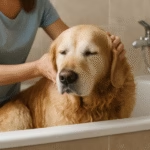How to Encourage Calm Behavior in Senior Golden Retrievers is my guide to a steady routine, gentle exercise, calm training, home enrichment, and vet partnership. I share what I do each morning and night, explain why routine lowers anxiety, describe low-impact walks and swimming that ease stiffness, cover gentle training and rewards that teach calm, show how I spot pain and work with my vet, and offer simple tips you can try today. For a broader look at keeping older Goldens relaxed, I also drew on ideas from how to keep senior Golden Retrievers calm.
Key Takeaway
- Keep a calm, steady daily routine
- Give short, gentle walks and low-impact exercise
- Offer soft toys and slow puzzles for calm play
- Use gentle praise and short training sessions
- Create quiet, comfy rest spots and consult the vet when needed
How to Encourage Calm Behavior in Senior Golden Retrievers with a steady daily routine
I learned early that consistency is the backbone of calm for my aging Golden. When thinking about How to Encourage Calm Behavior in Senior Golden Retrievers, I picture slow mornings, predictable walks, and the same quiet corner for naps. My dog reacts to signals—food, leash, voice—so regular timing helps him read my cues and relax. For ideas on setting predictable care patterns, I reference tips from simple daily care routines for senior Goldens.
A steady routine reduces surprises and helps me spot problems sooner. When his energy or appetite shifts from the usual pattern, I notice it quickly and can call the vet or adjust our day before stress builds.
Simple morning and evening schedule I follow
Mornings: let him wake up, a short leash walk where he can sniff, breakfast in the same spot, gentle brush.
Midday: short potty breaks, gentle attention.
Evening: short play or light training, dinner, quiet wind-down with soft music or a chew toy. I dim the lights at the same hour so his internal clock knows bedtime is near—this follows principles in the ideal sleep routine for elderly Goldens.
Why routine helps reduce anxiety
Routine gives him a map. Older Goldens can get confused by sudden changes; repeating simple steps removes choices that could stress him out. Predictable rhythms replace anxiety with trust, and I see him breathe deeper and rest longer.
Small shifts—softer voices, slower movements, padded mats, and lower bowls—made his posture and comfort improve almost immediately. For more on creating a peaceful home environment, see creating calm and peaceful environments for senior Goldens.
Gentle exercise I use to ease stiffness and keep my older dog calm
Small, steady movement is the best medicine for my old Golden—what I call “daily oiling.” Gentle exercise was one of the first things I tried when I asked How to Encourage Calm Behavior in Senior Golden Retrievers; it cut down pacing and whining in a week or two.
My routine mixes short walks, slow play, and light range-of-motion stretches. I watch body language closely—if he favors a leg or slows too much, I stop. Sessions are short and frequent so he moves without tiring. I pair movement with praise and soft pets so exercise feels safe and fun.
Low-impact walks and swimming
- Pick flat routes and soft ground (grass, packed dirt).
- Let him sniff—mental work matters as much as steps.
- Short walks two or three times a day beat one long trek.
- Swimming eases joint stress; start shallow with a life jacket and supervise.
These low-impact ideas tie into broader calm strategies described in maintaining calm for senior Goldens.
How regular movement reduces restlessness and pain-related agitation
Gentle exercise keeps joints mobile, lowers stiffness, and eases frustration. Movement also triggers feel-good chemicals and tires the brain in a healthy way. If agitation looks like true pain—whining, limping, loss of appetite—I stop and check with the vet.
Timing and pace I recommend for safety: several short sessions of 5–20 minutes, two to four times daily depending on how he feels. Warm up with gentle petting, keep a relaxed pace, and end with a soft treat or cuddle.
Gentle obedience training techniques for an older Golden Retriever
I slowed everything down. Fast moves and loud voices worked as a pup, but with age calm, steady signals get better results. I use clear, simple cues, soft body language, and stop if he seems tired.
I switched to low-impact rewards—tiny soft treats, gentle petting, happy words—and break commands into tiny steps so he wins often. Repetition is short and steady rather than long and intense. For more patient approaches, I follow ideas from training senior Goldens with gentle methods and gentle training approaches.
Positive reinforcement for calm behavior
Reward calm breathing and loose bodies, not perfect obedience. Praise the moment he relaxes with a tiny treat right then. Gentle shaping—marking small steps like a softer tail wag or a relaxed jaw—adds up over days. The benefits of this method are discussed in positive reinforcement works best for senior Goldens.
If you want a short practical approach to How to Encourage Calm Behavior in Senior Golden Retrievers, start by praising the smallest hint of calm and build from there.
Short sessions that suit reduced attention and mobility
Keep training sessions 5 minutes, three or four times a day. One quick command, a reward, then a rest or quiet walk. Mix mental work (nose games, scent searches, simple puzzle toys) with gentle movement. Stop early if he shows fatigue. For indoor options, see indoor training games for senior Goldens.
Using cue words and rewards to lower excitement
Choose calm cues like settle and easy in a soft voice. Pair the word with a slow stroke and a tiny treat. Over time the cue alone helps him relax. If he gets excited, wait for a pause, say the cue, and reward the quiet moment.
How I enrich my home to reduce stress and encourage calm behavior
For me, calm comes from comfort, routine, and gentle stimulation. I talk in low tones, keep light and noise steady, and maintain predictable meal and walk times.
I focus on comfort where he spends most time: soft rugs by the door, a raised or low-sided orthopedic bed, blackout curtains for naps, and rotating blankets that smell like home. I keep his space cool and ventilated.
Alongside comfort I add gentle enrichment: short, slow walks, light massage, and short scent games. I avoid long play sessions and high-impact toys. Slow puzzles and treat-dispensing toys make him think without wearing him out. For more mental activities you can use, see mental enrichment activities for senior Goldens and ways to keep your senior Golden’s mind active.
| Change I made | Why it helps | Items I use |
|---|---|---|
| Orthopedic bed with low side | Easier to climb, joint support | Egg-crate foam bed, washable cover |
| Predictable routine | Lowers anxiety and surprises | Same walk times, quiet afternoons |
| Scent and puzzle play | Mental lift without fatigue | Snuffle mat, slow feeder, small puzzles |
Safe spaces and soft bedding to reduce anxiety
I created calm corners: a quiet window view and a low platform bed outside main traffic. Beds are covered with soft washable blankets and a few familiar toys. I guide him to his corner when visitors come so he can rest until things quiet down. A heated pad for chilly nights and non-slip mats help him settle faster. For a full room setup, review ideas in creating comfort for my senior Goldens.
Toys, scent games and puzzles for enrichment
Pick soft, simple toys—no loud squeakers. Use soft treats or broken-up kibble in a snuffle mat. I hide tiny treats around a room for a short sniffing session (10 minutes max). Slow puzzle feeders at mealtime stretch thinking without overtiring him.
How I set up a soothing nap room: soft light, comfy bed, a worn T-shirt for scent, and gentle ambient sound or a low fan for white noise. Dim lights mid-day and keep the room cool and clutter-free.
Vet-recommended calming strategies and supplements I discuss with my vet
I start with simple fixes: softer walks, predictable routines, low-impact play, and swapping loud toys for gentler ones. I also ask about pheromone diffusers and supportive beds.
When behavior remains tense we discuss supplements. I bring notes on diet, meds, and stress reactions. Common options include L-theanine, melatonin, omega-3s, alpha-casozepine, and sometimes CBD oil. We weigh benefits, side effects, dose ranges, and realistic timelines—most supplements take weeks to show effects.
Ask the vet about interactions and whether bloodwork is needed first. Treat behavior changes as a puzzle: check for pain, vision or hearing loss, thyroid issues, or other medical causes before assuming it’s purely behavioral. If you’re wondering which behavior shifts are typical with age, see behavioral changes in aging Goldens.
| Supplement | Common form | Main reported benefit |
|---|---|---|
| L-theanine | Pill or chew | Calmer reactions to noise/stress |
| Melatonin | Tablet | Better sleep, less night pacing |
| Omega-3 (EPA/DHA) | Capsule or fish oil | Brain support, mood stability |
| Alpha-casozepine | Soft chew | Reduced mild anxiety |
| CBD oil | Oil or tincture | May lower anxiety (varies) |
Regulation and evidence vary by region—ask your vet.
When to consult the vet about behavior changes
Call the vet for new moods, sudden aggression, loss of house training, sharp appetite or sleep changes—these can signal pain, cognitive decline, thyroid issues, or other medical problems. Also consult before mixing supplements with prescription meds.
My checklist before starting any supplement:
- Get vet approval and note any tests needed
- Confirm no interactions with current meds
- Start at the lowest recommended dose
- Keep a daily log for 2–4 weeks
- Report worrying signs immediately
Spotting pain and treating causes of agitation
I watch my dog like a weather vane. Sudden grumpiness, less interest in walks, or night pacing often point to pain. I act fast: softer bedding, short gentle walks, and ramps can reduce agitation. If those don’t help, I call the vet for a pain check.
Treatments have ranged from joint supplements to short courses of pain meds and physical therapy. I mix medical help with comfort and quiet routines—meds calm the body but training calms the mind. For ways to coordinate care and strengthen your relationship while managing aging needs, see building stronger bonds with your senior Golden.
Signs I watch for that suggest discomfort or pain
| Sign | Possible cause | First actions |
|---|---|---|
| Limping or hesitating to jump | Arthritis or soft tissue pain | Reduce jumps, add ramps, vet check |
| Whining at night / pacing | Pain, discomfort, or cognitive change | Check for pain, warm bed, vet consult |
| Loss of appetite | Dental or GI pain | Inspect mouth, adjust food texture, vet exam |
| Sudden snappiness | Pain when touched | Stop handling, vet pain assessment |
| Licking/chewing one area | Local pain, hot spot | Clean area, protect from licking, vet advice |
Combining pain treatment with training
Step-by-step I follow:
- Treat pain medically or with therapy so movement is easier.
- Create a calm routine: same walks, same rest spots.
- Use very short training sessions focused on settle and slow breathing.
- Add enrichment that doesn’t strain joints: snuffle mats, slow feeders.
- Praise calm behavior and avoid punishing anxious signs.
I coordinate care with my vet and therapists by sharing logs, photos, and goals (less limping, fewer night wakings). Regular updates let us tweak meds or therapy quickly.
Quick checklist: How to Encourage Calm Behavior in Senior Golden Retrievers (practical steps)
- Set a predictable daily schedule (meals, walks, bedtime).
- Keep walks short, slow, and frequent; try swimming if possible.
- Use short training sessions (5 min) with tiny soft rewards.
- Create multiple calm corners with low beds and familiar scents.
- Use slow puzzles and scent games for gentle mental stimulation.
- Consult your vet for pain checks and before starting supplements.
- Log changes and adjust routines based on his responses.
Conclusion
Calm for a senior Golden isn’t a single trick—it’s a tapestry of steady routine, short gentle exercise, thoughtful enrichment, and vet-backed care. Small, predictable rhythms and short wins matter more than big fixes. I watch my dog closely, treat pain quickly, and keep training soft and positive. Simple tools—a low orthopedic bed, sniff games, a life jacket for swimming, calm cue words—made a night-and-day difference for us.
If you’d like more practical tips and real-life tricks, explore further resources such as the journey of aging: an owner’s experience and other articles on keeping senior Goldens calm. I hope these ideas bring more peaceful days to you and your Golden.

Rafael Souza is a digital marketing strategist and lifelong dog enthusiast. Passionate about Golden Retrievers, he shares practical, research-based tips to help owners provide healthier and happier lives for their furry companions.





